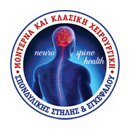
Lumbar microdiscectomy
Surgical technique
Percutaneous lumbar microdiscectomy, that is a discectomy performed with the assistance of tubes and the surgical microscope, is the most reliable way of a lumbar disc herniation removal. The use of the microscope has limited the complications of the discectomy to a percentage lower than 1%. This operation is a minimally invasive surgery and only an incision of 2–3cm long is required. It is always performed under general anesthesia and its duration is about 40–50 minutes.
![Simple X-rays of the lumbar spine with a tube placed in the L4–L5 intervertebral space (C-arm shot) [images taken from my personal archive]](https://www.neuroxeirourgos.gr/wp-content/uploads/2013/10/Simple-localizing-radiographs.jpg)
Simple X-rays of the lumbar spine with a tube placed in the L4–L5 intervertebral space (C-arm shot) [images taken from my personal archive]
The results are immediate and extraordinary as the patient only feels light pain in the incision area. The patient can move right after the anesthesia effect stops and they return home the next day. Most of the time, the removal of sutures is not required because absorbable subcutaneous sutures are used for the stitches.
What are the complications of the microdiscectomy?
As every other surgical operation, the microdiscectomy also has a limited amount of complications, such as hematoma, inflammation, cerebrospinal fluid leak, and so on. All of these complications can be treated and most of the time can be predicted. Moreover, preventive measures, such as the intravenous administration of antibiotics, are taken both intra- and postoperatively in order to prevent any postoperative infection.
For the aforementioned reasons, this method can be classified as a method of few incisions and complications.
What are the alternative surgical methods?
The most important alternative surgical method for a lumbar disc herniation removal is the classic microdiscectomy, which requires an incision 4–5cm long. However, the postoperative pain is more intense because a more extensive muscle ablation is required.






